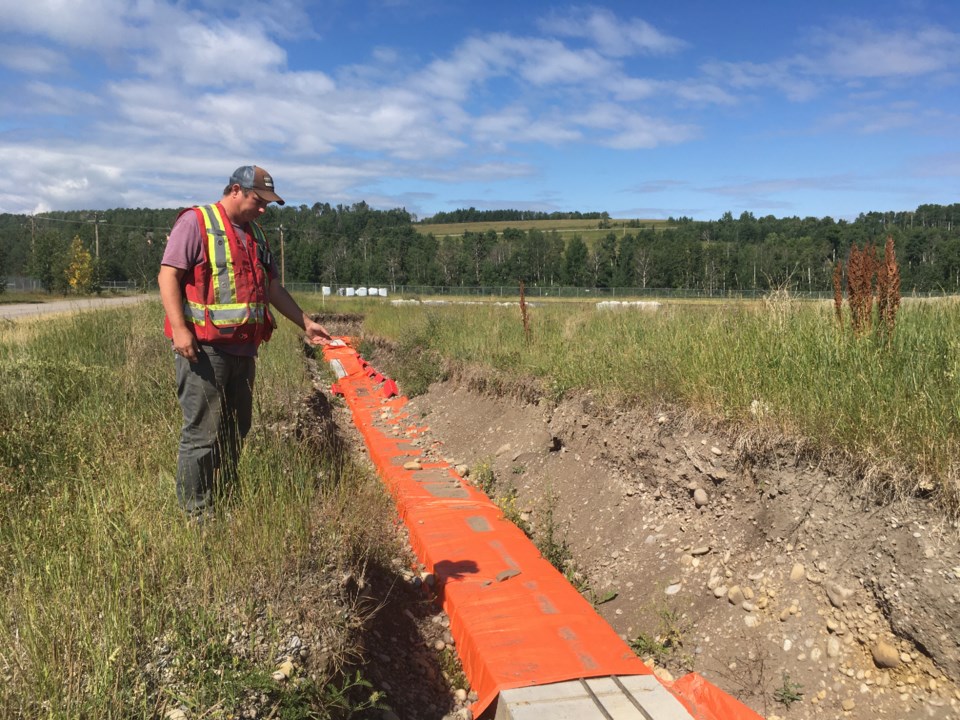SUNDRE – The one-year testing phase of the new wastewater treatment technology trialled in Sundre was completed last fall yielding results that reportedly exceeded new provincial standards.
However, there remains no estimated construction timeline for the assembly of the full-scale facility that will be integrated into the existing three-cell sewage lagoon system.
Council heard a project update on Dec. 16 during a regular meeting in a report presented by Linda Nelson, chief administrative officer.
Nelson told council that in late October, the municipality’s engineering firm McElhanny met with the technology’s designer Soneera as well as Alberta Environment and Protected Areas (AEPA) to discuss the results of the pilot program and testing regime along with lessons learned and a project overview.
“The town is currently undertaking a feasibility study, using information gleaned from the pilot process to estimate operating costs; and comparing these to other benchmark technologies for comparable, traditional treatment technologies,” she said, adding that once completed, the report will subsequently be sent to the province.
Among the next steps, she said, will be to participate in another meeting with AEPA “to discuss value added engineering based on the fact that water is becoming an increasingly precious commodity, and there is great value in putting clean water back into the system to reduce cumulative effects.”
But although the Soneera pilot project that employs a wastewater treatment process called electroflocculation (EF) is still awaiting its final reporting to AEPA, the 12-month testing phase wrapped up at the end of September, she said.
“AEPA validation upon receiving the final pilot report is still required to officially confirm compliance with AEPA effluent standards,” she said.
“Moving forward, the technology vendor intends to use the full-scale facility as a hub for ongoing research and development.”
Nelson told the Albertan that while the facility is effectively ready to assemble with a concrete footprint already in place, the final installation phase will not get underway until the municipality has officially received AEPA approval.
Although an estimated timeline has not been announced, the project is expected to be completed prior to the end of 2025, when all municipalities across the province will have to meet updated effluent standards.
The technology is intended to outlast the lifespan of a lagoon and boasts a much smaller footprint. Additionally, it is said to be scalable to meet the needs of small villages of fewer than 1,000 or even larger urban centres.
The building that is eventually expected to be assembled in Sundre has been designed for expansion based on potential town growth and the system will be seamlessly integrated into existing infrastructure and use the lagoons as storage and further settling. The sewage lagoon’s existing cells will not be decommissioned as that is an expensive process.
“The (EF) system does not use chemicals, membranes or filters, and as a result it is less costly to operate over time when compared to other mechanical systems,” said Nelson.
“(As of) today, we have completed all the testing that was required by Alberta Environment with outstanding results,” she said.
To ensure unbiased testing throughout the testing phase, the municipality commissioned a third-party engineering firm with expertise in wastewater and innovation to monitor testing regime, she said.
“A full 12 months of testing that shows the system successfully achieves the effluent targets set by the receiving stream study and Alberta Environment and Protected Areas is required to receive an APEA approval to operate the Soneera electroflocculation system long-term.”
MAGNA Engineering had throughout the testing phase submitted to the town and Alberta Environment a monthly report that described outcomes achieved through the system. Monitoring and testing were conducted weekly with the results averaged and summarized.
“We are pleased to report that the results of the testing have shown that we have exceeded the new provincial effluent limits that will be imposed on the treated wastewater discharged to the Red Deer River required under our new authorization for 2025.”
- RELATED: Testing on Sundre's new sewage treatment technology concluding
- RELATED: Testing underway on Sundre’s new wastewater treatment tech
- RELATED: Sundre wastewater treatment facility suffers 'one hold up after another'
- RELATED: Concrete foundation for Sundre’s new wastewater treatment upgrade complete
- RELATED: Construction starting on Sundre's pilot sewage treatment tech
- RELATED: Sundre's new wastewater treatment process proven
- RELATED: Cutting-edge wastewater facility could become trendsetter
- RELATED: New state-of-the-art pilot Sundre facility receives $7.5 million



